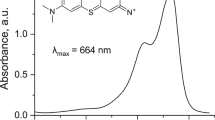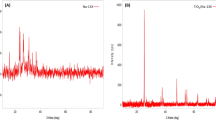Abstract
A bifunctional TiO2@ZnO nanorods hybrid material was synthesized via one-step hydrothermal synthesis and studied as an adsorbent for SPE of U(VI) and Th(IV) and as a photocatalyst for the photocatalytic removal of methylene blue (MB). The formation of TiO2@ZnO hybrid composite was confirmed by XRD, Raman, SEM, SEM–EDX and SEM-Mapping analysis. After determining the optimum values of the analytical parameters affecting the recovery of the analytes, the developed TiO2@ZnO hybrid NPs-SPE method was applied to natural waters with a high recovery efficiency (94–97%). The accuracy of the method was also verified by using CRM-TMDA 62.2 and TM-25.3 standards. Photocatalytic properties of the fabricated nanocomposite were investigated by degrading of MB under UV light. The results indicated that the synthesized TiO2@ZnO material can be used as a promising adsorbent/photocatalyst candidate for the adsorption of U(VI) and Th(IV) analytes in waters as well as the photocatalysis degradation of MB dyestuff.









Similar content being viewed by others
References
Yuvalı D, Narin İ, Soylak M, Yılmaz E (2020) Green synthesis of magnetic carbon nanodot/graphene oxide hybrid material (Fe3O4@C-nanodot@GO) for magnetic solid phase extraction of ibuprofen in human blood samples prior to HPLC-DAD determination. J Pharm Biomed Anal 179:113001. https://doi.org/10.1016/j.jpba.2019.113001
Ajayan PM, Schadler LS, Braun PV (2003) Nanocomposite science and technology. John Wiley & Sons. https://doi.org/10.1002/3527602127
Yılmaz E, Salem S, Sarp G, Aydın S, Sahin K, Korkmaz I, Yuvalı D (2020) TiO2 nanoparticles and C-Nanofibers modified magnetic Fe3O4 nanospheres (TiO2@Fe3O4@C-NF): a multifunctional hybrid material for magnetic solid-phase extraction of ibuprofen and photocatalytic degradation of drug molecules and azo dye. Talanta 213:120813. https://doi.org/10.1016/j.talanta.2020.120813
de Dios AS, Diaz-Garcia ME (2010) Multifunctional nanoparticles: analytical prospects. Anal Chim Acta 666:1–22. https://doi.org/10.1016/j.aca.2010.03.038
Kim D, Shin K, Kwon SG, Hyeon T (2018) Synthesis and biomedical applications of multifunctional nanoparticles. Adv Mater 30:1802309. https://doi.org/10.1002/adma.201802309
Liu S, Zhao Y, Shen M, Hao Y, Wu X, Yao Y, Li Y, Yang Q (2022) Hyaluronic acid targeted and pH-responsive multifunctional nanoparticles for chemo-photothermal synergistic therapy of atherosclerosis. J Mater Chem B 4:562–570. https://doi.org/10.1039/D1TB02000E
Karagoz S, Kiremitler NB, Sakir M, Salem S, Onses MS, Sahmetlioglu E, Yılmaz E (2020) Synthesis of Ag and TiO2 modified polycaprolactone electrospun nanofibers (PCL/TiO2-Ag NFs) as a multifunctional material for SERS, photocatalysis and antibacterial applications. Ecotoxicol Environ Saf 188:109856. https://doi.org/10.1016/j.ecoenv.2019.109856
Sarp G, Yılmaz E (2022) g-C3N4@TiO2@Fe3O4 multifunctional nanomaterial for magnetic solid-phase extraction and photocatalytic degradation-based removal of trimethoprim and isoniazid. ACS Omega 7:23222–23233. https://doi.org/10.1021/acsomega.2c0311
Hadei M, Mesdaghinia A, Nabizadeh R, Mahvi AH, Rabbani S, Naddafi K (2021) A comprehensive systematic review of photocatalytic degradation of pesticides using nano TiO2. Environ Sci Pollut Res Int 28:13055–13071. https://doi.org/10.1007/s11356-021-12576-8
Abd-Rabboh HHS, Galal AH, Aziz RA, Ahmed MA (2021) A novel BiVO3/SnO2 step S-scheme nano-heterojunction for an enhanced visible light photocatalytic degradation of amaranth dye and hydrogen production. RSC Adv 11:29507–29518. https://doi.org/10.1039/D1RA04717E
Tahir MB, Kiran H, Iqbal T (2019) The detoxification of heavy metals from aqueous environment using nano-photocatalysis approach: a review. Environ Sci Pollut Res 26:10515–10528. https://doi.org/10.1007/s11356-019-04547-x
Soylak M, Yılmaz E (2015) Determination of cadmium in fruit and vegetables by ionic liquid magnetic microextraction and flame atomic absorption spectrometry. Anal Lett 48:464–476. https://doi.org/10.1080/00032719.2014.949732
Vansteene A, Jasmin JP, Cote G, Mariet C (2018) Segmented microflows as a tool for optimization of mass transfer in liquid-liquid extraction: application at the extraction of europium (III) by a malonamide. Ind Eng Chem Res 57:11572–11582. https://doi.org/10.1021/acs.iecr.8b02079
Soylak M, Dogan M (1996) Column preconcentration of trace amounts of copper on activated carbon from natural water samples. Anal Lett 29:635–643. https://doi.org/10.1080/00032719608000426
Soylak M, Khan M, Yılmaz E (2016) Switchable solvent based liquid phase microextraction of uranium in environmental samples: a green approach. Anal Methods 8:978–986. https://doi.org/10.1039/C5AY02631H
Bezerra MA, da Mata F, Cerqueira UM, Ferreira SLC, Novaes CG, Novais FC, Valasques GS, Novaes da Silva B (2022) Recent developments in the application of cloud point extraction as procedure for speciation of trace elements. Appl Spectrosc Rev 57:338–352. https://doi.org/10.1080/05704928.2021.1916516
Shah F, Yılmaz E, Kazi TG, Afridi HI, Soylak M (2012) Vortex-assisted liquid–liquid microextraction coupled to flame atomic absorption spectrometry for lead determination: ionic liquid based microextraction using Triton X-100 as dispersant. Anal Methods 4:4091–4095. https://doi.org/10.1039/C2AY25773D
Jalili V, Barkhordari A, Ghiasvand A (2020) A comprehensive look at solid-phase microextraction technique: a review of reviews. Microchem J 152:104319. https://doi.org/10.1016/j.microc.2019.104319
Tuzen M, Parlar K, Soylak M (2005) Enrichment/separation of cadmium(II) and lead(II) in environmental samples by solid phase extraction. J Hazard Mater 121:79–87. https://doi.org/10.1016/j.jhazmat.2005.01.015
Azzouz A, Kailasa SK, Lee SS, Rascón AJ, Ballesteros E, Zhang M, Kim K-H (2018) Review of nanomaterials as sorbents in solid-phase extraction for environmental samples. TrAC Trends Anal Chem 108:347–369. https://doi.org/10.1016/j.trac.2018.08.009
Chen D, Cheng Y, Zhou N, Chen P, Wang Y, Li K, Huo S, Cheng P, Peng P, Zhang R, Wang L, Liu H, Liu Y, Ruan R (2020) Photocatalytic degradation of organic pollutants using TiO2-based photocatalysts: a review. J Clean Prod 268:121725. https://doi.org/10.1016/j.jclepro.2020.121725
Batra V, Kaur I, Pathania D, Chaudhary V (2022) Efficient dye degradation strategies using green synthesized ZnO-based nanoplatforms: a review. Appl Surf Sci 11:100314. https://doi.org/10.1016/j.apsadv.2022.100314
Büyüktiryaki S, Keçili R, Hussain CM (2020) Functionalized nanomaterials in dispersive solid phase extraction: advances & prospects. TrAC Trends Anal Chem 127:115893. https://doi.org/10.1016/j.trac.2020.115893
Yamakata A, Vequizo JJM (2019) Curious behaviors of photogenerated electrons and holes at the defects on anatase, rutile, and brookite TiO2 powders: a review. J Photochem Photobiol 40:234–243. https://doi.org/10.1016/j.jphotochemrev.2018.12.001
Turan NB, Erkan HS, Engin GO, Bilgili MS (2009) Nanoparticles in the aquatic environment: usage, properties, transformation and toxicity-A review. Process Saf Environ Prot 130:238–243. https://doi.org/10.1016/j.psep.2019.08.014
Cartwright A, Jackson K, Morgan C, Anderson A, Britt DW (2020) A review of metal and metal-oxide nanoparticle coating technologies to inhibit agglomeration and increase bioactivity for agricultural applications. Agronomy 10:1018. https://doi.org/10.3390/agronomy10071018
Ahangaran F, Navarchian AH (2020) Recent advances in chemical surface modification of metal oxide nanoparticles with silane coupling agents: a review. Adv Colloid Interface Sci 286:102298. https://doi.org/10.1016/j.cis.2020.102298
Soylak M, Yılmaz E (2010) Sorbent extraction of 4-(2-thiazolylazo) resorcinol (TAR)-metal chelates on Diaion SP-850 adsorption resin in order to preconcentration/separation. J Hazard Mater 182:704–709. https://doi.org/10.1016/j.jhazmat.2010.06.089
Wu K, Dong X, Zhu J, Wu P, Liu C, Wang Y, Wu J, Hou J, Liu Z, Guo X (2018) Designing biomimetic porous celery: TiO2/ZnO nanocomposite for enhanced CO2 photoreduction. J Mater Sci 53:11595–11606. https://doi.org/10.1007/s10853-018-2397-y
Xu CY, Zhang PX, Yan L (2001) Blue shift of Raman peak from coated TiO2 nanoparticles. J Raman Spectrosc 32:862–865. https://doi.org/10.1002/jrs.773
Zhao C, Wang W-J, Sun D, Wang X, Zhang J-R, Zhu J-J (2014) Nanostructured graphene/TiO2 hybrids as high-performance anodes for microbial fuel cells. Chem Eur J 20:7091–7097. https://doi.org/10.1002/chem.201400272
Kuriakose S, Satpati B, Satyabrata M (2015) Highly efficient photocatalytic degradation of organic dyes by Cu doped ZnO nanostructures. Phys Chem Chem Phy 17:25172–25181. https://doi.org/10.1039/C5CP01681A
Madhumitha G, Fowsiya J, Gupta N, Kumar A, Singh M (2019) Green synthesis, characterization and antifungal and photocatalytic activity of Pithecellobium dulce peel-mediated ZnO nanoparticles. J Phys Chem Solids 127:43–51. https://doi.org/10.1016/j.jpcs.2018.12.005
Xiang L, Liu X, Yang C, Lei Q, Zhao J, Zhao X (2021) Ultrafast synthesis of anatase TiO2 microspheres doped with rare-earth by one-step microwave method. Inorg Chem Commun 127:108532. https://doi.org/10.1016/j.inoche.2021.108532
Khayat Sarkar Z, Khayat Sarkar F (2013) Selective removal of lead(II) ion from wastewater using superparamagnetic monodispersed iron oxide (Fe3O4) nanoparticles as an effective adsorbent. J Nanosci Nanotechnol 9:109–114
Wang J, Jiang Z, Zhang L, Kang P, Xie Y, Lv Y, Xu R, Zhang X (2009) Sonocatalytic degradation of some dyestuffs and comparison of catalytic activities of nano-sized TiO2, nano-sized ZnO and composite TiO2/ZnO powders under ultrasonic irradiation. Ultrason Sonochem 16:225–231. https://doi.org/10.1016/j.ultsonch.2008.08.005
Khaki MRD, Shafeeyan MS, Raman AAA, Daud WMAW (2018) Evaluating the efficiency of nano-sized Cu doped TiO2/ZnO photocatalyst under visible light irradiation. J Mol Liq 258:354–365. https://doi.org/10.1016/j.molliq.2017.11.030
Zulfikar MA, Chandra AD, Rusnadi R, Setiyanto H, Handayani N, Wahyuningrum D (2020) TiO2/ZnO nanocomposite photocatalyst: synthesis, characterization and their application for degradation of humic acid from aqueous solution. Songklanakarin J Sci Technol 42:439–446. https://doi.org/10.14456/sjst-psu.2020.57
Chandrasekaran K, Karunasagar D, Arunachalam J (2011) Dispersive liquid-liquid micro extraction of uranium(VI) from groundwater and seawater samples and determination by inductively coupled plasma-optical emission spectrometry and flow injection-inductively coupled plasma mass spectrometry. Anal Methods 3:2140. https://doi.org/10.1039/C1AY05329A
Miyazaki A, Barnes RM (1981) Complexation of some transition metals, rare earth elements, and thorium with a poly (dithiocarbamate) chelating resin. Anal Chem 53:299–304. https://doi.org/10.1021/ac00225a040
Aydın F, Yılmaz E, Ölmez E, Soylak M (2020) Cu2O-CuO ball like/multiwalled carbon nanotube hybrid for fast and effective ultrasound-assisted solid phase extraction of uranium at ultra-trace level prior to ICP-MS detection. Talanta 207:120295. https://doi.org/10.1016/j.talanta.2019.120295
Zolfonoun E, Salahinejad M (2013) Preconcentration procedure using vortex-assisted liquid-liquid microextraction for the fast determination of trace levels of thorium in water samples. J Radioanal Nucl Chem 298:1801–1807. https://doi.org/10.1007/s10967-013-2684-7
Yousefi SR, Ahmadi SJ, Shemirani F, Jamali MR, Salavati-Niasari M (2009) Simultaneous extraction and preconcentration of uranium and thorium in aqueous samples by new modified mesoporous silica prior to inductively coupled plasma optical emission spectrometry determination. Talanta 80:212–217. https://doi.org/10.1016/j.talanta.2009.06.058
Zolfonoun E, Yousefi SR (2015) Sorption and preconcentration of uranium and thorium from aqueous solutions using multi-walled carbon nanotubes decorated with magnetic nanoparticles. Radiochim Acta 103:835–841. https://doi.org/10.1515/ract-2015-2466
Shariati S, Yamini Y, Zanjani MK (2017) Simultaneous preconcentration and determination of U(VI), Th(IV), Zr(IV) and Hf(IV) ions in aqueous samples using micelle-mediated extraction coupled to inductively coupled plasma-optical emission spectrometry. J Hazard Mater 156:21–28. https://doi.org/10.1016/j.jhazmat.2007.12.061
Akl ZF (2017) Sensitive quantification of uranium using cloud point extraction coupled with inductively coupled plasma-optical emission spectrometry. J Radioanal Nucl Chem 315:21–28. https://doi.org/10.1007/s10967-017-5642-y
Rezaee M, Khalilian F (2015) Determination of uranium in water samples using homogeneous liquid-liquid microextraction via flotation assistance and inductively coupled plasma-optical emission spectrometry. J Radioanal Nucl Chem 304:1193–1200. https://doi.org/10.4314/bcse.v33i1.1
Daneshvar G, Jabbari A, Yamini Y, Paki D (2009) Determination of uranium and thorium in natural waters by ICP-OES after on-line solid phase extraction and preconcentration in the presence of 2,3-dihydro-9,10-dihydroxy-1,4-antracenedion. J Anal Chem 64:602–608. https://doi.org/10.1134/S1061934809060112
Lin C, Wang H, Wang Y, Cheng Z (2010) Selective solid-phase extraction of trace thorium(IV) using surface-grafted Th(IV)-imprinted polymers with pyrazole derivative. Talanta 81:30–36. https://doi.org/10.1016/j.talanta.2009.11.032
Preetha CR, Preetha CR, Prasada Rao T, Prasada Rao T (2006) Preconcentration of uranium(VI) by solid phase extraction onto dicyclohexano-18-crown-6 embedded benzophenone. J Radioanal Nucl Chem 267:265–270. https://doi.org/10.1007/s10967-006-0042-8
Soylak M, Khan M, Alosmanov R, Shah J, Jan MR (2015) Solid phase extraction of uranium(VI) on phosphorus-containing polymer grafted 4-aminoantipyrine. J Radioanal Nucl Chem 308:955–963. https://doi.org/10.1007/s10967-015-4508-4
Khajeh M, Jahanbin E (2014) Application of cuckoo optimization algorithm-artificial neural network method of zinc oxide nanoparticles-chitosan for extraction of uranium from water samples. Chemometr Intell Lab Syst 135:70–75. https://doi.org/10.1016/j.chemolab.2014.04.003
Acknowledgements
This work was supported by a Research Fund of the Van Yüzüncü Yıl University (Project no TYL-2018-6900).
Author information
Authors and Affiliations
Corresponding author
Additional information
Publisher's Note
Springer Nature remains neutral with regard to jurisdictional claims in published maps and institutional affiliations.
Rights and permissions
Springer Nature or its licensor (e.g. a society or other partner) holds exclusive rights to this article under a publishing agreement with the author(s) or other rightsholder(s); author self-archiving of the accepted manuscript version of this article is solely governed by the terms of such publishing agreement and applicable law.
About this article
Cite this article
Aydin, F., Yilmaz, E., Demirkiran, G. et al. TiO2@ZnO nanocomposite: bifunctional material for solid phase extraction of U(VI) and Th(IV) and photocatalytic degradation of organic contaminant. J Radioanal Nucl Chem 332, 3879–3892 (2023). https://doi.org/10.1007/s10967-023-09082-1
Received:
Accepted:
Published:
Issue Date:
DOI: https://doi.org/10.1007/s10967-023-09082-1




